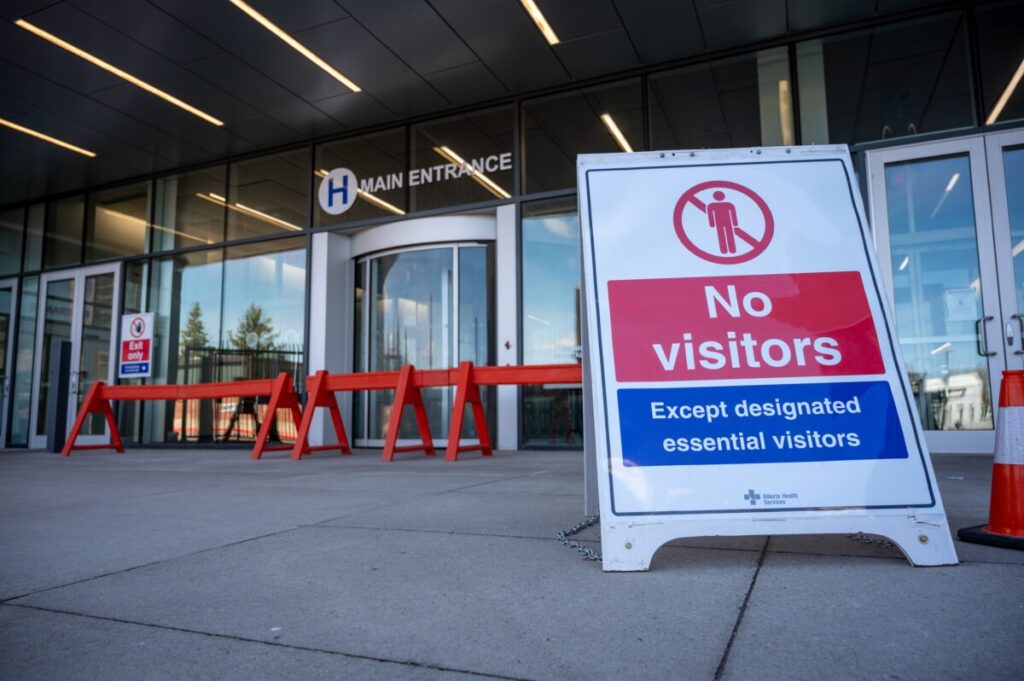In March and April 2020, in an effort to curb spread of COVID-19, nearly all hospitals across the country drastically restricted (and in many hospitals, entirely prohibited) family visitation. While intended to promote public health and save lives, these restrictions had devastating effects on families unable to be present with their loved ones.
Throughout the pandemic, many news stories have highlighted the great, even heroic, lengths that medical providers have gone through to mitigate these harms. Chaplains, social workers, and nurses have all played vital roles in providing physical acts of care and compassion and in finding new ways to connect patients and their families through technology. However, these news stories often fail to highlight the ways patients and families themselves act as moral agents in response to physical separation.
In recognition of this gap, this article is a case study on familial moral agency under the constraint of hospital visitation policies during COVID-19. For the purposes of this project, I begin with the following definitions:
A constraint is anything that limits possibility, freedom or choice.
Moral agency is any form of being or acting in morally relevant ways, according to a perceived good.
To access narratives of patients and families in the intensive care unit (ICU) during COVID, I interviewed three ICU chaplains who served within two hospital systems during the pandemic. Drawing from these interviews and my own experiences as a hospital chaplain, I offer two vignettes to illustrate the layers of constraint and varied forms of moral agency enacted by families, followed by a discussion of this case study’s contribution to broader reflection on moral agency under constraint.

Vignette 1: Resistance as Moral Agency
Maria is a Latina woman in her thirties, who speaks only Spanish.1 When her mother Sara was admitted to the hospital with COVID, she was walking and talking. However, over the course of several weeks, Sara was transferred to the ICU and intubated. During this time, due to visitation restrictions, Maria and her family were unable to visit Sara and reported receiving very few phone updates. Still, Maria and her family came to the hospital, day after day, requesting to visit their loved one, only to be turned away. Following her mother’s sudden death, Maria angrily narrated this series of events to me:
So many times, we try to visit, you all say ‘No.’ We came here on Friday and Saturday and Sunday, and you turned us away. And now, this morning, you call us and you say ‘Come, come,’ now that she is dead.
This unfolding of events led Maria to suspect that her mother’s death was due to neglect from the medical team. Overwhelmed with grief and shocked by her mother’s physical appearance after not seeing her for weeks, Maria took countless photos of her mother’s body to gather evidence of what she suspected to be medical malpractice. Reflecting on his wife’s death, Sara’s husband told me in no uncertain terms:
My wife died of loneliness. She came in here walking and then over the weeks she was here, separated from her loved ones, she slowly got worse and worse.
This tragic case illustrates several layers of constraint imposed by COVID visitation policies:
- Decreased Communication: Maria’s report of infrequent updates and her shock at her mother’s physical appearance demonstrate the significant impact of visitation policies on medical communication. What could once be gathered by the family member’s presence and perception was now reduced to brief (and depending on the medical team’s caseload, perhaps infrequent) phone conversations in which a doctor or nurse attempted to communicate verbally the medical status, prognosis, and treatment of their loved one. Even from the most clear, compassionate providers, this form of communication often failed to provide the family with adequate information.
- Heightened Distrust and Inequity in Communication: This case also highlights how decreased communication exacerbated existing medical distrust, especially among families of color. Moreover, this case points to inequities in telecommunication with non-English speaking families. Given the increased workload and staff shortages among medical professionals during COVID, the additional step of calling an interpreter to contact a family often resulted in less frequent calls and updates for non-English speaking families.
- Inability to Participate in Care Team: Sara’s husband’s belief that his “wife died of loneliness” points to this significant constraint. Many families understand themselves to be an essential part of the care team – whether through advocacy or healing presence. Due to physical separation, families are unable to ensure their loved one’s best care from medical providers or to offer what they understand to be key components of a patient’s healing – often, love, emotional support, physical touch, etc.
In the context of such constraints, Maria’s story exemplifies resistance as a form of moral agency. While relatively infrequent, these families resisted visitation restrictions entirely and showed up physically to the hospital, regardless of the response of the hospital staff. Whether they were turned away or let in as an exception, these families persistently showed up, demanding to be seen.
This vignette offers just one example of resistance as moral agency. Other families resisted these policies more subtly: by seeking an exception to visitation policies, calling whichever hospital employee will help advocate for them, moving as far up the chain as necessary, and/or invoking any power or privilege for their cause.
Vignette 2: Acquiescence as Moral Agency
Barry is a Black man in his 50s whose mother was admitted to a COVID ICU for multiple weeks. Over the course of his mother’s hospital stay, unable to be physically present with her, Barry experienced significant anxiety and concern about his mother’s condition. Therefore, initially, he called frequently for updates, often multiple times a day. However, he described to his chaplain that over time he experienced increasing impatience from medical staff due to the frequency of his calls. For example, he recalled one nurse telling him:
Well you called this morning. Nothing changed. She still has COVID. She’s still in the ICU.
Similarly, Barry spoke about another instance when a nurse responded:
Well, do you want me to take care of your mother or talk to you on the phone?
In recognition of the medical team’s growing frustration, Barry began to call less often in order to ensure better care for his mother. After a few weeks, while still COVID-positive and intubated in the ICU, his mother was no longer infectious to others, resulting in a change in her isolation status. When medical staff communicated this change to Barry, they did not specify explicitly that this change in isolation status meant that he was now allowed to visit in person. And though Barry did not understand the meaning of this change, he did not inquire further, feeling disenfranchised from previous calls. Eventually, Barry’s mother died in the COVID ICU, and due to this tragic miscommunication, Barry was unable to visit her in person before her death.
Barry’s story highlights the varied and shifting modes of acquiescence as forms of moral agency under constraint. Some families called the hospital frequently, attempting to receive as many updates as possible to make up for their absence, while others feared that calling too frequently would frustrate nurses or doctors and result in a lower quality of care for their loved one. Just as Barry shifted the frequency of his calls to ensure the best care for his mother, many family members move between these forms of agency at different stages of their journey, depending on the patient’s medical condition, the medical team’s response, the family’s emotional processing, and their social location.
Lessons about Moral Agency under Constraint
I believe this case study in familial moral agency under the constraint of COVID visitation policies offers three significant lessons for broader study of moral agency under constraint.
1) Expanded Definition of Constraint
First, this case study helps expand and clarify my initial definition of constraint. Returning to my definition of constraint as “anything that limits possibility, freedom or choice,” this case study helps extend this definition beyond how constraints limit families’ actions to incorporate how constraints prevent families from fulfilling their obligations (as parents, siblings, children, friends, etc.). Moral agents, like Maria and Barry, are not only constrained in their actions (by not being able to visit their loved ones as they desire) but are also constrained in the kinds of relationships they hold to their loved ones and in the moral transformation that takes place through these relationships. In other words, unable to visit their hospitalized loved ones, what kinds of parents, siblings, or children are these agents able to be and become?
2) Moral Ambiguity of Constraints
Second, this study illustrates the morally ambiguous nature of many constraints. For instance, nearly all hospital administrators and medical professionals understood these visitation policies to serve the purpose of curbing viral spread and saving lives. These policies were not only widely supported by medical professionals but by the public at large. In this sense, these policies themselves were a form of moral agency under the constraint of COVID-19. This demonstrates the way policies can function simultaneously as a form of moral agency, and while unintended, as a constraint of families in their actions and relationships to their hospitalized loved ones. Naming this moral ambiguity allows for more nuanced discussion about any given policy’s intent and impact and invites appropriate critique and transformation, regardless of initial intent.
3) Varied Moral Frameworks of Agents
Finally, this study sheds light on the varied moral frameworks in which different moral agents operate. For example, many medical professionals (out of great care and compassion) seem to operate with a utilitarian logic and continue “to define the best good in essentially clinical terms, weighing the cost of pursuing one clinical strategy against another” with metrics such as infection rates, hospitalizations and deaths.2 On the other hand, family members, while understanding of the need to curb infection and prevent death, seem to operate within a different moral framework, which recognizes a tragic incommensurability of values. Within this framework, familial obligations cannot be weighed against public health data according to a common metric to maximize a singular good. Instead, tragic conflict between these incommensurable values is inevitable – either risk of infection will occur or familial obligations will be unmet. By juxtaposing these distinct moral frameworks, it becomes clear that families’ desire to visit their loved ones is not a failure in moral reasoning, to appreciate public health data, or to understand the gravity of the pandemic. Instead, their desire emerges from their relational obligations to their loved ones and the distinct moral insights these relationships bring.
Conclusion
As the COVID-19 pandemic continues and varied forms of visitation restrictions remain in many settings, this case study offers potential guidance for those in the medical community who strive to promote the health and well-being of patients, families, and the broader public. By valuing the distinct moral insights of family members alongside public health data, the medical community can depict more fully and reason better about the moral implications of any potential policy. For medical professionals, these insights not only allow for the creation of more just, equitable policies, but also might cultivate increased empathy and compassion in their provision of care by providing a window into the lived experiences of families.
Want to know more about this author? Click here!
